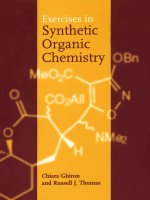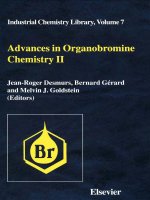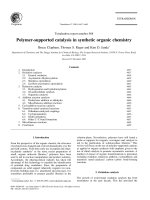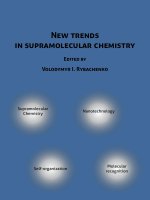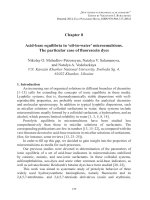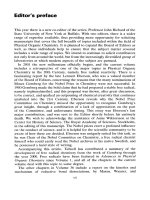Advances in physical organic chemistry 42
Bạn đang xem bản rút gọn của tài liệu. Xem và tải ngay bản đầy đủ của tài liệu tại đây (3.4 MB, 383 trang )
www.pdfgrip.com
Advances in Physical Organic Chemistry
www.pdfgrip.com
ADVISORY BOARD
B. Feringa University of Groningen, The Netherlands
E. Fukuzumi Osaka University, Japan
E. Juaristi CINVESTAV-IPN, Mexico
J. Klinman University of California, Berkeley
C. Perrin University of California, San Diego
Z. Rappoport The Hebrew University of Jerusalem, Israel
H. Schwarz Technical University, Berlin, Germany
C. Wentrup University of Queensland, Australia
www.pdfgrip.com
Advances in
Physical Organic Chemistry
Volume 42
Editor
J. P. RICHARD
Department of Chemistry
University at Buffalo, SUNY
Buffalo, NY 14260-3000, USA
Amsterdam – Boston – Heidelberg – London – New York – Oxford
Paris – San Diego – San Francisco – Singapore – Sydney – Tokyo
Academic Press is an imprint of Elsevier
ACADEMIC
PRESS
www.pdfgrip.com
Academic Press is an imprint of Elsevier
84 Theobald’s Road, London WC1X 8RR, UK
Radarweg 29, PO Box 211, 1000 AE Amsterdam, The Netherlands
Linacre House, Jordan Hill, Oxford OX2 8DP, UK
30 Corporate Drive, Suite 400, Burlington, MA 01803, USA
525 B Street, Suite 1900, San Diego, CA 92101-4495, USA
First edition 2008
Copyrightr 2008 Elsevier Inc. All rights reserved
No part of this publication may be reproduced, stored in a retrieval system
or transmitted in any form or by any means electronic, mechanical, photocopying,
recording or otherwise without the prior written permission of the publisher
Permissions may be sought directly from Elsevier’s Science & Technology Rights
Department in Oxford, UK: phone (+44) (0) 1865 843830; fax (+44) (0) 1865 853333;
email: Alternatively you can submit your request online by
visiting the Elsevier web site at and selecting
Obtaining permission to use Elsevier material
Notice
No responsibility is assumed by the publisher for any injury and/or damage to persons
or property as a matter of products liability, negligence or otherwise, or from any use
or operation of any methods, products, instructions or ideas contained in the material
herein. Because of rapid advances in the medical sciences, in particular, independent
verification of diagnoses and drug dosages should be made
ISBN: 978-0-12-374093-9
ISSN: 0065-3160
For information on all Academic Press publications
visit our website at books.elsevier.com
Printed and bound in Great Britain
08 09 10 11 12 10 9 8 7 6 5 4 3 2 1
www.pdfgrip.com
Contents
Editor’s Preface
ix
Contributors to Volume 42
xi
Cycloaromatization reactions: the testing ground for theory and experiment
1
IGOR ALABUGIN, BORIS BREINER and MARIAPPAN MANOHARAN
1
2
3
4
5
6
7
Introduction: bonds lost and bonds formed, or chemical bookkeeping 1
Cycloaromatization reactions: breaking p-bonds and breaking the rules 2
The diversity of cycloaromatization reactions 3
The relative role of s- versus p-effects at the early reaction stage 6
s-Effects on reactant stability 10
p-Effects on reactant stability 22
Transition state effects: communication of orthogonal
orbitals in the transition state of radical-anionic cyclizations 23
8 Effects on product stability 27
9 Conclusion 31
References 31
N-Acyloxy-N-alkoxyamides – structure, properties, reactivity and
biological activity
35
STEPHEN A. GLOVER
1
2
3
4
5
6
Introduction 35
Synthesis 39
Structure 43
Chemical reactivity 59
Biological activity of N-acyloxy-N-alkoxyamides
Conclusions 115
Acknowledgements 116
References 117
97
The Interplay between experiment and theory: computational NMR
spectroscopy of carbocations
HANS-ULLRICH SIEHL
1 Introduction 125
2 Alkyl and cycloalkylmethyl cations 126
v
125
www.pdfgrip.com
vi
3
4
5
6
7
8
9
10
CONTENTS
Vinyl cations 133
Cycloalkyl cations 142
m-Hydrido-bridged carbocations 144
Bicyclic and polycyclic carbocations 145
p-Stabilized carbocations 150
Heteroatom stabilized carbocations 156
Final remarks 158
Conclusions 160
Acknowledgments 160
References 160
Dynamics of guest binding to supramolecular systems: techniques
and selected examples
167
TAMARA C.S. PACE and CORNELIA BOHNE
1
2
3
4
Introduction 167
Techniques 169
Examples of supramolecular dynamics studies 185
Conclusions 216
Acknowledgements 217
References 217
Mechanisms of oxygenations in zeolites
225
EDWARD L. CLENNAN
1
2
3
4
Introduction 225
Zeolites 226
Experimental considerations 230
Intrazeolite photooxygenations 232
Acknowledgement 261
References 262
Metal-catalyzed alcoholysis reactions of carboxylate and
organophosphorus esters
271
R. STAN BROWN and ALEXEI A. NEVEROV
1
2
3
4
5
Introduction 271
Background theory 274
Titrations in alcohol 276
Metal ion alcoholysis and titration in alcohol 278
Transition metal ion and Ln3+ catalysts of transesterifications of neutral carboxylate and
organophosphate esters 284
www.pdfgrip.com
CONTENTS
6 Transition metal ion and La3+-catalysis of the alcoholysis of phosphate diesters
7 Conclusions 324
Acknowledgements 325
References 325
vii
308
Author Index
333
Cumulative Index of Authors
351
Cumulative Index of Titles
353
Subject Index
363
www.pdfgrip.com
This page intentionally left blank
www.pdfgrip.com
Editor’s Preface
Volume 42-Advances in Physical Organic Chemistry
The six chapters in this volume each focus on a significant topic in organic chemistry, and branch out to include themes from biochemistry, theoretical chemistry,
and materials chemistry.
The cyclization reaction of linear enediynes to form aromatic ring compounds
has attracted the attention of organic chemists, because of the extensive electronic
reorganization involved. There has been a tremendous increase in interest in
the parent Bergman cyclization reaction since the discovery that this and related
reactions play a central role in the in vivo activation of tumor-specific DNA cleaving
agents. Igor Alabugin presents a lucid description of the interplay between experimental and theoretical studies to map the electronic reorganization that occurs as
one moves from the linear enediyne reactant to the partly aromatic transition state
for these complex reactions.
The generation of carbocations in strongly acidic media, and the characterization
of their structure by NMR in the 1950s was a breathtaking accomplishment that led
to the award of the Nobel Prize in Chemistry to George Olah. Over the past 50 years
NMR spectroscopy has evolved as the most important experimental method for
the direct study of structure and dynamics of carbocations in solution and in the
solid state. Hans-Ullrich Siehl provides an excellent review of computational studies
to model experimental NMR spectra for carbocations. This chapter provides an
example of how the fruitful interplay between theory and experiment has led to a
better understanding of an important class of reactive intermediates.
Supramolecular systems perform complex chemistry not accessible to their molecular components. These systems are extraordinarily difficult to study, because of
the diverse set of skills required for the design, synthesis, characterization, and
mechanistic analyses of a single supramolecular complex. The chapter by Cornelia
Bohne focuses on a particularly valuable skill, and presents an overview of modern
techniques used for kinetic analyses of reactions that occur in supramolecular
complexes, with an emphasis on the characterization of fast reactions. Zeolites
are aluminosilicate solids with cavities of dimensions comparable in size to small- or
medium sized organic molecules. Many fascinating questions have been raised about
the effect of confinement of organic reagents in these cavities on chemical reactivity.
The progress towards answering these questions for oxygenation reactions in
zeolites is reviewed in a chapter by Edward Clennan.
ix
www.pdfgrip.com
x
EDITOR’S PREFACE
The design of catalysts of the cleavage of RNA and DNA, and the determination
of the mechanism for these cleavage reactions has considerable intellectual appeal,
and the potential to produce cleavage reagents with applications in medicine. These
studies are most-often carried out in water, with the ultimate aim of developing
in vivo applications for particularly powerful catalysts. It has become clear in recent
years that the activity of these catalysts is sometimes reduced in water compared
with alcohol solvents with lower dielectric constants than water. This observation
has proven useful in developing conditions for detoxification of organophosphorus
nerve agents by alcoholysis reactions. The chapter by R. S. Brown summarizes the
results of recent studies on the mechanism for metal-catalyzed alcoholysis reactions
of carboxylate and organophosphorus esters. In the second chapter with a biological
theme, Stephen Glover summarizes what is known about the structure, physical,
spectroscopic, chemical and biological properties of N-acyloxy-N-alkoxyamides.
The convergence of several functional groups at a single nitrogen results in
interesting chemical properties for these compounds as well as in their mutagenic
activity, which is a useful probe for drug-DNA interactions.
John P. Richard
University of Buffalo
www.pdfgrip.com
Contributors to Volume 42
Igor Alabugin Department of Chemistry and Biochemistry, Florida State
University, Tallahassee, Fl 32306-4390, USA
Cornelia Bohne Department of Chemistry, University of Victoria, PO Box 3065,
Victoria, BC, V8W 3V6, Canada
Boris Breiner Department of Chemistry and Biochemistry, Florida State
University, Tallahassee, Fl 32306-4390, USA
R. Stan Brown Department of Chemistry, Queen’s University, Kingston, Ontario
K7L 3N6, Canada
Edward L. Clennan Department of Chemistry, University of Wyoming, 1000
East University Avenue, Laramie, WY 82071, USA
Stephen A. Glover School of Science and Technology, University of New England,
Armidale, NSW 2351, Australia
Mariappan Manoharan Department of Chemistry and Biochemistry, Florida
State University, Tallahassee, Fl 32306-4390, USA
Alexei A. Neverov Department of Chemistry, Queen’s University, Kingston,
Ontario K7L 3N6, Canada
Tamara C.S. Pace Department of Chemistry, University of Victoria, PO Box
3065, Victoria, BC, V8W 3V6, Canada
Hans-Ullrich Siehl Institute of Organic Chemistry I, Ulm University, AlbertEinstein-Allee 11, D-89069, Ulm, Germany
xi
www.pdfgrip.com
This page intentionally left blank
www.pdfgrip.com
Cycloaromatization reactions: the testing
ground for theory and experiment
IGOR ALABUGIN, BORIS BREINER and MARIAPPAN MANOHARAN
Department of Chemistry and Biochemistry, Florida State University,
Tallahassee, FL, USA
1 Introduction: bonds lost and bonds formed, or chemical bookkeeping 1
2 Cycloaromatization reactions: breaking p-bonds and breaking
the rules 2
3 The diversity of cycloaromatization reactions 3
4 The relative role of s- versus p-effects at the early reaction stage 6
5 s-Effects on reactant stability 10
Strain and antiaromaticity in cyclic enediynes 11
Control of strain through ligand–metal coordination 16
Steric assistance of ortho substituents 17
Control of steric repulsion with positively charged ortho substituents 20
Hybridization effects 21
6 p-Effects on reactant stability 22
7 Transition state effects: communication of orthogonal orbitals in the transition state of
radical-anionic cyclizations 23
8 Effects on product stability 27
s-Effects 27
p-Effects 30
9 Conclusion 31
References 31
1 Introduction: bonds lost and bonds formed, or chemical
bookkeeping
Chemical reactions involve the reorganization of electron density in which bonds are
broken and formed in accordance with the reaction mechanism. The energetic consequences of such reorganization are accounted for by the reaction thermodynamics.
Unless a very weak bond is broken with a significant increase in entropy, bond
breaking is thermodynamically unfavorable and leads to the formation of highly
reactive intermediates: radicals and diradicals through bond homolysis, anions and
cations through heterolysis, and carbenes as a result of a-elimination. On the other
hand, bond formation is favorable and when a strong bond is formed, serves as a
thermodynamic sink that often terminates a cascade of chemical transformations,
thus balancing the thermodynamic checkbook or registering a profit.
In a perfect world of balanced checkbooks, the bond breaking and bond forming
processes are synchronized, as it happens (albeit not always perfectly) in concerted
pericyclic reactions. Even when such synchronization is not perfect, unimolecular
1
ADVANCES IN PHYSICAL ORGANIC CHEMISTRY
VOLUME 42 ISSN 0065-3160 DOI: 10.1016/S0065-3160(07)42001-9
r 2008 Elsevier Inc.
All rights reserved
www.pdfgrip.com
2
I. ALABUGIN ET AL.
rearrangements are still rarely accompanied with a change in the number of chemical
bonds. In other words, the number of chemical bonds generally is conserved.
2 Cycloaromatization reactions: breaking p-bonds and breaking
the rules
An interesting breakdown of the tendency for the conservation of chemical bonds
occurs in the so-called cycloaromatization reactions1 (Scheme 1).
In these reactions, a s-bond is formed at the expense of two p-bonds and, thus, the
process leads to a net loss of one chemical bond that is intrinsically unfavorable
thermodynamically. Formation of the new s-bond leads to ring closure, whereas the
net loss of a bond leads to the formation of two radical centers, which can be either
inside (the ‘‘endo’’ pattern in Scheme 1) or outside of the newly formed cycle
(the ‘‘exo’’ pattern). Note that s-radicals are formed through the endo path, while
exo-closures may produce either a s-radical when a triple bond is involved or a
conjugated p-radical when the new bond is formed at the central carbon of an allene.
The parent version of this process is the transformation of enediyne 1 into p-benzyne
diradical2 (the Bergman cyclization), shown in Scheme 2.
This transformation requires significant thermal energy to overcome the activation barrier and is endergonic. The endergonicity of the Bergman cyclization is not
surprising and stems logically from the net loss of a bond in the product. What is
surprising is that the energy penalty (DH) for this intrinsically unfavorable
a
X
a
X
c
b
X
b
endo, endo
endo, exo
c
c′
X
X
exo, exo
bis-allene
exo, exo
bis-alkyne
Scheme 1 Schematic representation of cycloaromatization reactions. Double lines correspond to the out-of-plane p-systems of a bis-alkyne reagent. Only orbitals of the in-plane
p-system in the reactant and of new s-bond and radical centers in the product are shown
explicitly.
www.pdfgrip.com
CYCLOAROMATIZATION REACTIONS
3
H
.
2RH
1
.
2
H
Scheme 2 Bergman cyclization of (Z)-3-ene-1,5-diyne.
transformation is only 8–9 kcal/mol.3 This low value results from the aromatic
stabilization of the product provided by the completely conjugated system of out-ofplane p-orbitals at each carbon of the enediyne system. Thus, even though the outof-plane p-array does not directly participate in the bond forming/bond breaking
event, it is not a simple bystander in the overall process. Developing aromatic
stabilization in the conjugated out-of-plane system plays an important role in deepening the potential energy well for the diradical product to the extent that this
species can be trapped by external reactions such as H-atom abstraction or addition
to a p-system.
The goal of this review is to dissect the relative contributions of the two
orthogonal p-systems in the most general sense and provide a clear and general
analysis of electronic effects in the Bergman cyclization as they apply to and originate from these two different sources. We will outline the relative role of the two
systems in defining the kinetics and thermodynamics of the parent Bergman
cycloaromatization pathway, delineate factors that affect these systems separately
and discuss ways to provide communication between the two orthogonal p-systems.
This review will be selective rather than comprehensive since a number of excellent
and detailed reviews are available on various aspects of the chemistry (and biochemical application) of cycloaromatization reactions in the recent literature: Rawat
and Zaleski4 compared and contrasted geometric and electronic effects in thermal
Bergman cyclizations to those of the recently developed metalloenediynes, while
Basak and coworkers5 concentrated even more closely on the use of enediynyl
ligands in chelation-controlled Bergman cyclizations. The Schreiner group6 reviewed
the application of computational methods toward a variety of cycloaromatization
reactions and Koănig and coworkers7 provided a compendium of experimental
results related to the electronic effects on the Bergman cyclization. Intricate details
of biological activity of natural enediynes were most recently reviewed by Shen and
coworkers,8 whereas medicinal utility of designed enediynes was expertly discussed
by Jones and Fouad.9
3
The diversity of cycloaromatization reactions
Fig. 1 summarizes cyclizations of the two prototype molecules, (Z) hex-3-ene-1,5diyne and (Z) hept-3,5,6-triene-1-yne. In all of these processes, bonds are formed
from in-plane p-orbitals in the presence of an orthogonal p-system. However, it is
clear that the properties of the newly formed cyclic conjugated systems can be quite
www.pdfgrip.com
4
I. ALABUGIN ET AL.
a
a
b
b
Schreiner
Bergman
c
d
d
c
Schmittel
Myers-Saito
Fig. 1 Cycloaromatization reactions of (Z) hex-3-ene-1,5-diyne and (Z) hept-3,5,6-triene1-yne.
X
X
R
R′
R
R′
X = NH, O, S, PH,
+
+
+
NH2 , OH , SH ,
CH-, etc.
Scheme 3 Formation of 5-membered heterocycles through cyclization reaction.
different. A new aromatic system is formed only in the Bergman and Myers-Saito
cyclizations, and thus, in a sense, only these two processes in Fig. 1 are bona fide
cycloaromatization reactions. Note also that s,s-diradicals are produced from
enediynes, whereas s,p-diradicals are formed from enyne allenes.
The benzene ring is not the only aromatic moiety that can be formed in a
cycloaromatization process and formation of other aromatic systems was considered
as the driving force of new cycloaromatization processes. For example, Matzger
(X ¼ S)10 and Schreiner11 investigated whether the 5-membered aromatic heterocyclic systems of pyrrole, thiophene, and furan can be formed in these processes
(Scheme 3), while Alabugin12 (Scheme 4) and Rabinovitz13 (Scheme 5) investigated
anionic species where cycloaromatization benefited (albeit to a different extent) from
the aromaticity of the cyclopentadienyl anion.
Whitlock et al.14 discovered a reductive cyclization of enediynes promoted by
lithium naphthalenide that provides substituted fulvenes and suggested a dianionic
mechanism (Scheme 6). However, even now it is still unclear whether the enediyne
dianion is indeed the cyclizing species or whether the initially formed acyclic radicalanion cyclizes first to give a fulvene radical-anion which is further reduced by
lithium to give the cyclic dianion.
Aromaticity of the products is only one of the factors accounting for the efficiency
of these cyclizations as evidenced by the discovery of a dianionic synthesis of nonaromatic 5-membered heterocycles by Tamao and coworkers who found that reduction of bis(phenylethynyl)dialkylsilanes with lithium naphthalenide resulted in
formation of a cyclized product by endo–endo cyclization15 (Scheme 7).
Under analogous conditions, cyclic 1,2-bis(silylethynyl)benzenes afford 1,4-dilithio-2,3-disylylnaphthalenes via dianionic endo–endo cyclization leading to the
formation of a 6-membered ring (Scheme 8).16
www.pdfgrip.com
CYCLOAROMATIZATION REACTIONS
F
5
F
F
N
N
F
+.
-.
F
F
N
F
hv
F
F
F
F
F
F
F
F
F
N
F
*
F
F
F
F
N
N
F
F
F
H
R
R
R
R
R = tetrafluoropyridinyl
(TFP)
H
Scheme 4 Reductive C1–C5 cyclization of enediynes.
Δ
K, 2H
I2
Scheme 5 Thermal and reductive cyclizations of cross-conjugated enediynes.
Along similar lines, Wenthold applied the radical-anionic idea to the Cope
rearrangement,17 which can be considered a more saturated analog of the Bergman
cyclization.18 The radical-anionic Cope rearrangement was found to have an
inverted potential energy surface with the cyclic intermediate being more stable
than the radical-anion corresponding diene. Consequently, one-electron reduction of 2,5-dicyano-1,5-hexadiene results in spontaneous cyclization under the
experimental conditions.
Certainly, the role of photochemical excitation may be displayed in different
ways19 and even in those cases when no aromatic system is formed, topologically
www.pdfgrip.com
6
I. ALABUGIN ET AL.
D
1. Li / naphthalene
2. D2O
D
Scheme 6 Dianionic cyclization of enediynes promoted by double lithium naphthalenide
reduction.
Ph
Ph
Ph
Ph
lithium naphthalenide
(4 equivalents)
Si
R
Li
Li
Si
R
R
R
Scheme 7 Dianionic endo–endo cyclization of diethynylsilanes.
Li
Si
Si
lithium
naphthalenide
Si
Si
Li
Scheme 8 Endo–endo reductive cyclization of cyclic 1,2-bis(silylethynyl)benzenes.
similar cyclization photoreactions are still possible. A classic example involves the
photochemical cyclization of diethynylmethanes discovered by Zimmerman and
Pincock20 around the same time as the thermal Bergman cyclization was reported by
Bergman. The reaction proceeded upon direct irradiation of the diyne in isopropyl
alcohol or, alternatively, when triplet-sensitized by acetophenone or xanthone.
As in the Bergman cycloaromatization, two hydrogen atoms are abstracted from a
suitable donor (Scheme 9).
Taken together these data suggest that the family of cycloaromatization reactions
will continue to grow and new interesting transformations may be discovered in the
future.21 Thus, understanding of general factors which can be used to control
cycloaromatization process should be of significant value for organic chemistry.
4
The relative role of r- versus p-effects at the early reaction stage
Although data presented in the previous section illustrate the diversity of
cycloaromatization reactions, most of the following discussion will concentrate on
the Bergman cyclization – a reaction that has been studied intensively in recent
decades due to its role in the mechanism of biological activity of natural anticancer
antibiotics.8,9 We will take advantage of the large body of data produced by this
www.pdfgrip.com
CYCLOAROMATIZATION REACTIONS
7
hν
2-propanol
Scheme 9 Photochemical cyclization of diethynylmethanes. Although this reaction is topologically analogous to the cyclization reactions discussed earlier, it does not lead to an aromatic product.
research and use this archetypal reaction to illustrate the general electronic factors
involved in a typical cycloaromatization process.
Since both in-plane and out-of-plane p-systems are involved, a clear dissection of
their respective roles in the cycloaromatization process is beneficial for the analysis
of electronic effects on reactivity. Galbraith et al.22 approached this problem by
utilizing valence bond (VB) theory, which provided insight into the structural and
electronic nature of the transition state and illustrated the role of the s- and
p-frameworks. The dominant VB configuration in the enediyne was found to play
only a small role in the p-benzyne diradical, while the role of the dominant VB
configuration (accounting for the biradical) in the product was seemingly insignificant in the starting material. The avoided crossing of the energy curves of these two
VB configurations leads to the transition state, but the changes in the electronic
wave function and in geometry are non-synchronous. The transition state (TS) was
found to be $80% product-like geometrically and $70% reactant-like electronically
in an apparent violation of the Hammond postulate.23 This is a direct consequence
of the high stabilization energy provided by the formation of the aromatic system,
the development of which only has significance once the reaction approaches the
product.
Independently, Alabugin and coworkers utilized classic molecular orbital (MO)
correlation diagrams for understanding cycloaromatization processes. The advantage of this approach is that it clearly describes changes accompanying the cyclization process at the level of individual MOs and allows comprehensive analysis of
electronic reorganization that accompanies the cyclization processes including the
relative roles of the two orthogonal p-arrays.
As an example of the latter approach, let us analyze the MO correlation diagram
for the Bergman cyclization of the parent enediyne given in Fig. 2. This diagram
shows the transformation of MOs of the starting material to MOs of TS and the
product. The most important change at the TS stage is the dramatic increase in the
energy of HOMO-1 of the enediyne, which is paralleled by the decrease in the energy
of LUMO+1 due to the transformation of these in-plane orbitals (bonding and
antibonding respectively) into non-bonding MOs (radical centers). Destabilization
of the HOMO-1 is the most dramatic energy penalty that the molecule has to pay to
reach the TS. This effect is partially offset by the s-bond forming interaction that
stabilizes HOMO-2 (in phase combination of the in-plane enediyne p-orbitals).
Developing aromatic stabilization of the out-of-plane p-system lags behind the
www.pdfgrip.com
8
I. ALABUGIN ET AL.
A
S
A
S
LUMO
A
LUMO
HOMO
S
HOMO
A
S
A
S
Reactant
TS
Product
Fig. 2 MO correlation diagrams for the Bergman cyclization (adopted from ref.24). Out-ofplane MOs are shown in black, in-plane MOs are shown in blue.
above changes but becomes progressively more and more important as the reaction
coordinate approaches the p-benzyne product.
The above correlation diagrams can be used to illustrate the relative timing of
changes in the s- and the p-systems. It is obvious from Fig. 2 that at the TS stage the
s-system is more involved in the electronic reorganization process and that changes
in the out-of-plane p-system mostly occur after the cyclization TS is passed. This
analysis eliminates description of the Bergman cyclization as a 6e electrocyclic
reaction that involves the out-of-plane p-system (Fig. 3). The Bergman cyclization
should be considered the first step of an asynchronous [2+2] cycloaddition, interrupted by the aromatic stabilization of the intermediate 1,4-diradical, or as a Cope
rearrangement interrupted by aromatic stabilization of the TS.18
www.pdfgrip.com
CYCLOAROMATIZATION REACTIONS
9
Fig. 3 Incorrect description of the Bergman cycloaromatization as a 6p-electrocyclic ring
closure (top). A better description shown for comparison (below).
It is interesting to use MO correlation diagrams for a comparison of the two
alternative cyclizations of enediynes (Fig. 4): the Bergman cyclization and the
C1–C5 cyclization (Fig. 1b,a), investigated first computationally by Schreiner.25
In both these processes, a s bond is formed at the expense of the same two in-plane
p-bonds in either an endo–endo (Bergman) or an endo–exo (C1–C5) fashion (Fig. 4).
Not surprisingly, the changes in in-plane MOs are comparable in the two diagrams
and consistent with these p-bonds being broken in order to form the new s-bond.
In contrast, changes in the out-of-plane MOs are significantly different. In contrast
to the Bergman cyclization where the enediyne highest occupied molecular orbital
(HOMO) is strongly stabilized, such stabilization is small in the non-aromatic
didehydrofulvene product of the C1–C5 cyclization. Another interesting difference is
that the LUMO+2 of the reactant correlates with the lowest unoccupied molecular
orbital (LUMO) of the product in the C1–C5 cyclization instead of LUMO+1.
Such changes illustrate the different properties of the out-of-plane conjugated
systems formed in the two processes (aromatic for the Bergman and non-aromatic
for the C1–C5 cyclization).
The above analysis illustrates why it is helpful to consider the enediyne moiety as
two independent p-systems. As discussed above, the conjugated out-of-plane
p-system of the reactant is smoothly transformed into the conjugate p-system of the
product (e.g., the aromatic system of benzene) without an overall change in the
number of bonds. We will refer to this group of electrons as ‘‘out-of-plane MOs’’ or
simply as ‘‘the p-system’’. In contrast, the two in-plane p-bonds are transformed in
a more drastic way to the new s-bond and a pair of radical centers. We will refer to
this system of orbitals as ‘‘in-plane p-bonds’’ or as ‘‘the s system’’.
Since the breaking p-bonds and the developing radical centers are orthogonal to
the out-of-plane p-system and the aromatic system develops mostly after the system
proceeds through the transition state, the activation barrier for the Bergman
cyclization is relatively insensitive to effects in the p-system. This provides a
challenge for the substituent control of such reactions: it is not always clear whether
hyperconjugative and inductive s-effects are sufficiently strong to control these
reactions efficiently. On the other hand, the well understood p-effects are usually
indirect and they display themselves mostly in reaction thermodynamics.27
Due to the different role of s- and p-effects, we will separate the general
description of electronic effects into s- and p-effects in this study. s-Effects include
www.pdfgrip.com
10
I. ALABUGIN ET AL.
LUMO+2
(reactant)
LUMO+1
(reactant)
H
H
Energy
Energy
H
HOMO
H
HOMO
H
H
Reaction cooordinate
Reaction cooordinate
Fig. 4 The crossings of in-plane and out-of-plane frontier MOs in the radical-anionic
Bergman and C1–C5 cyclizations, respectively calculated at the B3LYP/6-31G** level.
Adapted from reference26.
the in-plane p- and s-orbitals. We will analyze these effects (which can be either
stabilizing or destabilizing) at the three reaction stages (reactants, TS, and products)
separately. All three possibilities can have a significant effect on the reaction enthalpy and activation energy of the cycloaromatization reaction. The ability to
influence the reaction at or near the transition state provides the most direct way to
control the reaction rates but reactant stabilization/destabilization is also a viable
approach. Effects on the products are indirect but can be readily understood using
dissection of kinetic and thermodynamic contributions to the reaction barrier
provided by the Marcus theory, an approach that we used in the analysis of other
pericyclic reactions28 and radical cyclizations.29
5
r-Effects on reactant stability
In a seminal work, Koga and Morokuma suggested that the high activation energy
of the Bergman cyclization is due to the strong electron repulsion between the
www.pdfgrip.com
CYCLOAROMATIZATION REACTIONS
11
in-plane occupied acetylene p-orbitals.30 These authors also pointed out that the
lower activation energy of the Myers-Saito cyclization can be attributed to the
decrease in electron repulsion due to the transoid orientation of the interacting
p-orbitals.31
Recently, we analyzed the role of electron repulsion relative to bond breaking and
antiaromaticity effects on a quantitative basis using Natural Bond Orbital (NBO)
analysis.24 Two other destabilizing factors were considered at the initial stage of the
cyclization in addition to four-electron repulsion between the filled in-plane
acetylenic p-orbitals – distortion/breaking of the acetylenic bonds as a result of
their bending, and the fact that, at a distance of ca. 3 A˚, the in-plane p-orbitals
become parallel and reach a geometry that resembles the antiaromatic TS of the
symmetry forbidden [2s+2s] cycloaddition (vide infra).
STRAIN AND ANTIAROMATICITY IN CYCLIC ENEDIYNES
The effect of cyclic constraints that bring the two ends of the enediyne system closer
together is extensively studied. This is not surprising because nature utilizes the
higher reactivity of cyclic enediynes in the naturally occurring enediyne antibiotics.
When the enediyne moiety is incorporated in a large cycle (more than 10 carbon
atoms), the Bergman cyclization is not fast enough to proceed at physiologically
relevant temperatures. In contract, enediynes in 9-membered cycles are too unstable
to be isolated (unless stabilized by additional electronic effects, vide infra), whereas
10-membered enediynes cyclize within hours (Fig. 5, Table 1).32 Nicolaou and
coworkers33 suggested a simple empirical criterion based on ‘‘the c–d distance’’ (the
proximity of the terminal carbons of the enediyne moiety) as a measure of increased
ring torsion, which is relieved when the compounds undergo the Bergman cyclization. Only below the ‘‘critical upper limit’’ (the c–d distance of 3.2–3.3 A˚), the
cyclization is expected to proceed at a measurable rate at ambient temperature.
More elaborate analysis incorporates the relative strain energies of the ground and
c
(CH2)n
d
c
OH
c
OH
c
OH
c
d
OH
d
OH
d
O
O
d
I
OH
II
III
O
IV
Fig. 5 Cyclic model enediynes used by Nicolaou to establish the critical distance model.
www.pdfgrip.com
12
I. ALABUGIN ET AL.
Table 1 Calculated c–d distances and stabilities of cyclic enediynes
Compound
n
Ring Size
c–d Distance (A˚)
Stability
I
II
III
IV
1
2
3
–
–
–
–
9
10
11
10
10
10
10
2.84
3.25
3.61
3.20
3.29
3.34
3.42
Unknown
t1/2 ¼ 18 h at 251C
Stable at 251C
t1/2 ¼ 11.8 h at 371C
t1/2 ¼ 4 h at 501C
t1/2 ¼ 2 h at 501C
Stable at 251C
Cl
Cl
Fig. 6 Cyclization of the first isolable a 9-membered enediyne.
transition states.34,35 In the 11-membered system, the distance is only slightly larger
(ca. 3.5 A˚), yet such enediynes are rather unreactive.36
Overall, 9-membered enediynes are usually too unstable to be utilized in the
design of new anticancer drugs. An interesting way to overcome this limitation was
shown recently by Jones and coworkers who utilized an electronic effect in a rare
example of intentional deceleration of the Bergman cyclization (Fig. 6). Substitution
of a hydrogen atom with a chlorine atom at the vinylic position of a 9-membered
cyclic enediyne37 decreased the cyclization rate and allowed the first enediyne
with a 9-membered ring to be isolated. Nevertheless, the half-life of this compound
was found to be only 6 min at 313 K, corresponding to an activation barrier of
o18 kcal/mol.
An extensive computational analysis expanded the range of the c–d distances for
reactive cyclic enediynes to 2.9–3.4 A˚.38 By comparing unsubstituted enediynes with
dialkyl-substituted enediynes, it was found that the activation enthalpy is dependent
on factors other than the c–d distance and that reactivity hinges on a subtle interplay
of steric and electronic effects that accompany distortion caused by incorporation into a macrocycle. For example, since alkyl substituents stabilize acetylenic
bonds to a greater extend than olefinic bonds,39 such substituents stabilize the
starting material, thus increasing both the activation barrier and the reaction
endothermicity.
Despite the contribution of the above factors, it is clear that bending of the
two alkyne moieties toward each other increases the energy of the system as
illustrated by the three plots in Fig. 7.24 These plots illustrate the relation between
the ring size and calculated cyclization parameters in more detail and dependence
of the total energy of the system from the c–d distance. Interestingly, simple
bending of alkyne moiety reproduced the effect of cyclic restraints reasonably well.
A similar conclusion has been reached even earlier by Kraka and Cremer.40
